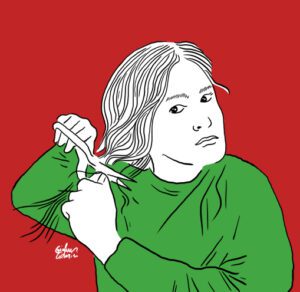
Nancy Nesvet
In an incredibly busy, enlightening, and fulfilling two months, writers and editors at Art Lantern and the New Art Examiner visited and assessed the differing means and aims of art fairs and Biennales across the globe, gleaning important insights which we pass on to you, our readers, in this issue. We hope to make you aware of the distinctions between art fairs and biennales that we have endeavored to point out: that art fairs are largely economic endeavors where galleries and artists exhibit work priced to sell. In contradistinction, biennales do not price work, or sell work, but exhibit work to educate and inform the public about issues important and relevant to our existence on this planet. Bringing together masses of visitors from the art world and beyond, they largely accomplish their mission.
The differences in aims of the art fairs and Biennales are initially apparent from their designs. Whereas art fairs delineate each booth into its own kingdom, with border walls separating each gallery space from the others, Biennale Curator-chosen Biennale exhibits often exist with no border walls, as did the 2023 Venice Architectural Biennale Arsenale sector, in room-size open spaces, so viewers are aware of the work of other artists and artist groups from each vantage point. Art fairs are largely financed by participating galleries that sell work to recoup their costs and make money beyond those costs. Lately, and certainly in the art fairs covered in this issue, there is a concerted effort to show work concerned with social and economic justice. Whether that is due to the audience’s concern, and therefore willingness to purchase work reflecting that concern, or whether the galleries are finding great work that reflects that preference is debatable.
Financing Biennale exhibits is more difficult. National pavilion’s exhibits are financed by the participating nation, limited to those who are recognized with an embassy in Italy, where Curators can adhere to any theme they like, and choose any art they wish to display. Recognizing institutional donors who step up to make Biennale exhibits financially possible, where governments cannot or do not, Lesley Lokko, this year’s Curator at the Architecture Biennale in Venice thanked the large institutional donors for their support in righting systemic resource inequality enabling artists and artist teams to participate in the 18th Architecture Exhibition at Venice. She convincingly wrote: “What the participants in this Biennale have managed to show is that equal opportunity is rightly and inevitably the basis for any discipline, particularly the creative arts.
Individuals have no control over the measure in which talent manifests in one person …but individuals, through the state, control the circumstances in which creativity flourishes. The all important task of state and institutional support cannot be left to philanthropists or the free market to provide and resolve.” (Lesley Lokko, Curator of the 18th International Architecture Exhibition, Venice 2023.
Elizabeth Ashe reviews an exhibition at the Beyeler Fondation in Basel, during Art Basel week which turned out the best installation she saw. Accompanying but not an official part of the Venice Architectural Biennale, Elizabeth Ashe also reviewed an exhibition in Venice at Palazzo Mora. Isabella Chiadini recounts the role of the Bumblebee Collective where Iranian students successfully navigated the art world, to make us all aware of the loss of rights and lives of Iranian women. Requiring few funds, proving the creativity of artists to achieve their goals no matter their economic circumstances, they produced a simply conceived but incredibly effective project.
Margaret Lanterman visited the Navy Pier 2023 Chicago Expo, an art fair on Navy Pier that straddled the border of Biennales with its special exhibit section showing the climate focused HOW ON EARTH exhibit and Janet Biggs’ video “Weighing Life Without a Scale”. Like the Lithuanian/Finnish exhibit at the Venice Architectural Biennale 2023, teaching children about forest ecology as they played with tree limbs, the Chicago Public Schools Project documented children’s art at the Chicago Expo, proving that play and artmaking educates for the children’s future and teaches them to take care of their future world.
Mary Fletcher’s review of a book about Claude Cahun introduces us to a daring, innovative true character who we were probably not aware of.
Marc Bloch exhaustively visits four New York Art Fairs, taking him from downtown to way uptown, from old to new fairs, pointing out the differences in each.
Gabrielle Bejani, a newly minted graduate of the Slade School of Art in London writes her assessment of London Photo Fair, adding valuable current insights about work presented.
I had the pleasure of reviewing Hilma af Klint’s and Piet Mondrian’s show at the Tate Britain, following the careers of two wonderful artists who started out painting landscape and later painted a philosophy inspired by spirituality.
Although not part of an art fair or Biennale, Eleonora Schiarchi’s speakeasy about Tin Bota, the disastrous flooding in Emilia Romagna used photographs and videos on social media to document the devastation and appeal to citizens of the world to help. Using the net when a physical space was not available or preferable to reach so many, recalled Lesley Lokko’s, the Curator of the Venice Architectural Biennale this year’s insistence that philanthropists cannot bear all the burden, but that individuals must be creative in providing help where needed.
We hope, with this overview to give you a taste of the differences in fairs and Biennales in our present art world so, if you cannot be physically present, you can virtually visit. Have fun, learn, discuss the art with friends and colleagues, and most of all, enjoy your forays into the art world with us.

